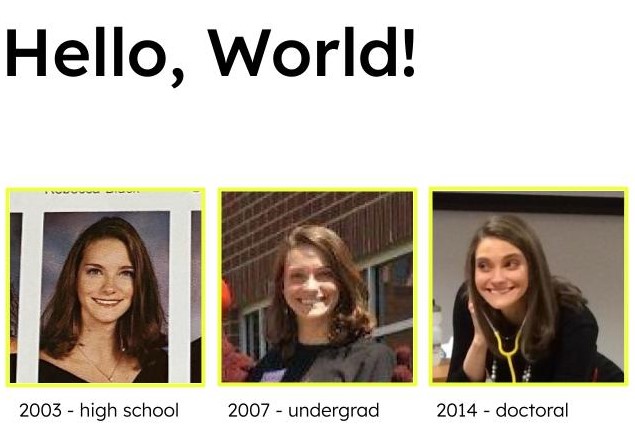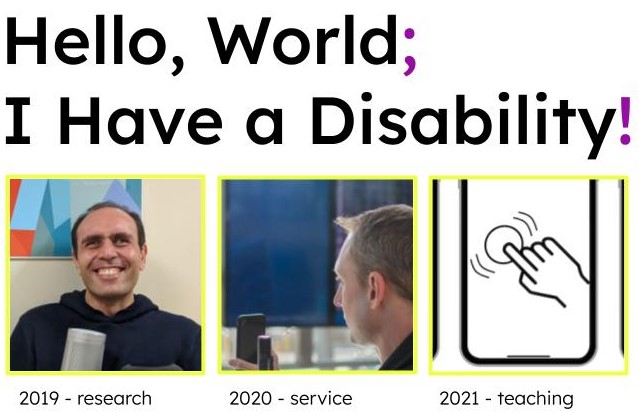Stacy Branham Breaks Down Barriers with “Hello World! I Have a Disability” Keynote
Belting out a few lines from the classic Singin’ in the Rain showtune “Good Morning,” Stacy Branham made it clear to her Tapia 2022 audience that her presentation, “Hello World! I Have a Disability.,” would not be your typical research talk. But Tapia — as the premier venue to acknowledge, promote and celebrate diversity in computing — isn’t your typical research conference.
Branham, an informatics professor in UCI’s Donald Bren School of Information and Computer Sciences (ICS), had been invited as a featured speaker at the conference. “When I was thinking about who would be in the audience, I knew there would be undergraduates and graduate students in computing who all have some sort of minoritized identity,” says Branham, explaining her decision to discuss her struggles as a woman in computing with an invisible disability. She knew these would be people who care about diversity, equity and inclusion (DEI), so she wanted to build awareness among this supportive community. Yet, she also pondered what might have been useful for her to hear as a young student.
“I think it would have been hearing someone say that they are struggling with mental illness,” she says. “I want to create spaces in computing where it’s okay to acknowledge who we are, where we come from, and actually see how embracing that can bring us joy and purpose in our computing careers and help us make things better for the people who are coming up behind us.”
So, on Thursday, Sept. 8, 2022, to convince every individual in that Tapia 2022 audience to stay in computing, Branham shared her own journey, breaking it down into three parts (the video and slides are available online). “I’m a true believer that if the computing professionals of today shared some of the minoritized identities and the lived experiences of the people at this conference, then the world would be a better place,” she said. “So we need you to stay.”
The Need for Representation in Computing
It has been reported that a third of minority students leave STEM majors, so Branham’s plea for people to remain in computing addressed a real need. It was also a plea born from experience. In Part 1 of Branham’s talk, “Hello, World!,” she shared that after falling in love with computing in high school, she almost left the field during her college years because she felt “miserable.” She talked of being one of four femme-presenting people of the 100 students in her first computer science course, and of the “sexist shenanigans” and microaggressions experienced during graduate school.

Yet she also talked about becoming the president of the Association of Women in Computing, doing undergraduate research, and learning how she could use computing as a vehicle for self-discovery and social change. She talked about taking an intersectional feminism course and doing her doctoral dissertation on feminist modes of communication. She persevered, and her love of computing eventually returned.
“At this point, I thought I had it all figured out,” she said. “I had my bachelor’s degree in computer science and my Ph.D. in computer science, but my understanding of myself was about to be shaken again.”
The Forgotten Category of Marginality
The Centers for Disease Control and Prevention estimates that 26% of adults in the U.S. have some type of disability, so Part 2 of Branham’s talk, “I Have a Disability,” addressed yet another challenge in society. She talked about how, as a postdoc in 2014 studying assistive technology, she realized that all of her knowledge and degrees had only taught her how to make ablest designs. “I had never once thought about how people with disabilities use computers. I did not know how to make accessible technology,” she said, noting that although she was an advocate for DEI, she had been leaving out an entire class of people.

“Disability is the forgotten category of marginality [and] we need to add it back in,” she said. “That’s why I get really excited when people start talking about DEI…A! Diversity, equity, inclusion and accessibility!” But in talking about accessibility, it’s critical to acknowledge there are both visible and invisible disabilities.
“I have a mental disability, which is a highly stigmatized category of disability in our society,” admitted Branham. “I can count the number of people who I’ve told about my disability in detail on two hands. I thought today we’d up that by a couple of orders of magnitude.”
Branham identifies as having complex post-traumatic stress disorder (cPTSD), which has led to a low sense of self-worth, anxiety, panic attacks and depression, as well as to Trichotillomania, characterized by compulsive hair pulling. But through her research, she learned healthier ways of understanding her disability. “Disability isn’t just about what’s inside of you and the work you need to do on yourself,” she said. “It’s also about the work that needs to happen outside of us and in society.” So Branham came to view her disability not just as a weakness but as a strength, bringing clarity to her work — as well as to her ways of dealing with her disability. “Slowly, over time,” she announced, “with therapy sessions and medication, I got better.”
The Joy of Celebrating Your Identity
Part 3 of the talk, “Hello World; I Have a Disability!” is where Branham talks about finally finding her voice in computing. “When I wrote my first ‘hello world!’ program, I thought it was the computer saying ‘hello, world!’” she said, using her best impersonation of a robotic computer voice. “But it wasn’t. It was always me, always you, making it say that.” She no longer thinks the hello world program is complete without bringing in that piece of herself, which is why she stresses that her revised punctuation matters. “Semicolon, because they’re not separate sentences. Exclamation point, because disability brings me joy, community, purpose.”

Branham’s identity is now an integral part of everything she does, from her research collaborations and service to the community, to her teaching. She spoke of her work with Ali Abdolrahmani, a recent Ph.D. graduate who is legally blind, in creating a navigation voice assistant called Jamie. She talked about partnering with Toyota and the Dayle McIntosh Center (for independent living) during the pandemic to provide Aira, a visual interpreter service, to people with visual disabilities. She also talked about a program at UCI to teach undergraduate students how blind people use smartphones so the students could then remotely train older adults losing their vision on how to use smartphones nonvisually. [Branham has also touched on such topics as part of her Inclusive Human-Centered Design course at UCI]. Finally, Branham spotlighted Access Computing, an NSF-funded, cross-institutional program that aims to increase the participation of people with disabilities in computing fields by working closely with students and through institutional and industry partnerships.
“You can’t leave your identity at the keyboard,” she stressed, and, in closing, reiterated her three main pieces of advice. One, know yourself. “In spaces where you feel like you don’t fit in, don’t interpret that as not having value,” she said. “Oftentimes, it’s the exact opposite.”
Two, find your people. “Find the people who make you feel most like yourself,” she said, “who reaffirm you, your experience, and your values.”
Finally, do your work. “Do the thing that only you can do because of who you are and what experiences you have,” she said. “Computing is just a tool to make the change you want to see in the world.”
— Shani Murray